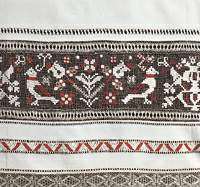Juraj Zajonc
Creating textile structures from a single thread with knotting is the basis for two separate textile techniques – lace and netting. Even though lace and netting have their origin outside Slovakia and came into our textile culture by many routes and in different periods, these techniques (especially netting) were the basis for creating unique manifestations of traditional textile culture, and they can still be found in the repertoire of active manual textile techniques. The greatest impetus for spreading this technique in nineteenth century Europe was the Encyclopaedia of Female Work, written by Thérése de Dillmont and published by D.M.C. Frivolitka probably started to spread into the urban environment in Slovakia due to this publication as well as other books published at the beginning of twentieth century in Germany and other countries. Its last renaissance took place in the 1960s through new stimuli impacting individuals as well as handwork associations from the Czech Republic and Germany. Netting is one of the oldest textile techniques, evidenced by prehistoric excavations of parts of fishing nets. Netting of various density was probably known at the time of Great Moravian Empire in the territory of Slovakia, proven by findings of weights as a part of fishing nets and, mainly, bone and metal netting needles from the eighth and ninth centuries found in Mikulčice. In the fifteenth century netting spread to higher society in Europe. Many netted textiles used in churches were gifts from rich ladies. Netted textiles from Upper Hungary are characterised by their rich motifs, taken mainly from western European pattern books published in the sixteenth and seventeenth centuries, mainly in Italy and Germany. Village women started using the technique of tying nets together with embroidery motifs for their own use and became acquainted with it mainly in high society and church workshops. Therefore the eighteenth and nineteenth centuries can be considered as a flourishing period for folk netted and embroidered textile in Slovakia. While some of the ornamentation from previous centuries certainly remained in folk netted textiles, village women continually made them simpler. At the same time, embroidered netted works started to feature flowers, waves, hearts and other new elements enriched by their creators. Folk cap embroidery was created by netting, and in some parts of Slovakia whole folk caps. Netted embroidery also decorated the lower part of aprons and also altar cloths. Netting lasted until the 1950s in the village environment, while in parts of Northeast Slovakia some of the older women still wear netting folk caps. Nowadays, netting is only sporadically used for creating decorative and textile accessories; however, there are currently moves for reviving it for interest group activities.
